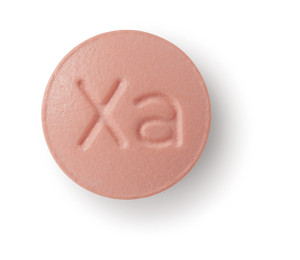Xarelto is an oral anticoagulant developed recently by Bayer, and approved by the U.S. FDA. It is a blood-thinning drug.
Xarelto is a selective inhibitor of Factor Xa which is used in the prevention of stroke and venous embolism in patients with chronic atrial fibrillation, as well as treatment and prevention of deep venous thrombosis and pulmonary embolism.

Xarelto is available in tablets of 10, 15 and 20 mg, and the recommended dose in adults is 10 to 20 mg once daily depending upon indication and renal function.
Compared with warfarin, a traditional blood thinner, Xarelto® has some advantages, including fewer interactions with food and other drugs, rapid onset, and freedom from the need to have periodic blood test monitoring. And whereas its effects wane within a short time frame after cessation, typically within a day or so, the effects of warfarin persist for many days after discontinuation.
What Are The Indications of Xarelto® And Who Should Use it?
Xarelto is approved to be used for the treatment of patients with following indications:
- Xarelto is indicated to reduce the risk of stroke and systemic embolism in patients with nonvalvular atrial fibrillation.
- There are limited data on the relative effectiveness of Xarelto® and warfarin in recuding the risk of stroke and systemic embolism when warfarin is well-controlled.
- Xarelto® is indicated for the treatment of deep vein thrombosis (DVT)
- Xarelto® is indicated for the treatment of pulmonary embolism (PE)
- Xarelto® is indicated for the reduction in the risk of recurrence of DVT and of PE following initial 6 months treatment for DVT and/or PE
- Xarelto® is indicated for the prophylaxis of DVT, which may lead to PE in patients undergoing knee or hip replacement surgery
What are the Side Effects of Xarelto?
Anticoagulants have long been known to significantly decrease the rate of stroke (by more than 50%), but they also prevent clotting in locations and situations where clotting is necessary. In other words, they can cause bleeding.
Xarelto, like other anticoagulants, is associated with bleeding adverse events (5% to 6%, major in ~1%), but these are no more frequent than with low molecular weight heparins or warfarin. Side effects not directly attributable to the anticoagulant activity of rivaroxaban are not common, but can include nausea, abdominal discomfort, back pain, anorexia, fever, and skin rash.
Premature discontinuation of Xarelto® increases the risk of thrombotic events
Premature discontinuation of Xarelto, in the absence of adequate alternative anticoagulation, increases the risk of thrombotic events. An increased rate of stroke was observed during the transition from Xarelto® to warfarin in clinical trials involving atrial fibrillation patients.
Risk of bleeding
Xarelto can cause bleeding, which can be serious, and rarely may lead to death. This is because Xarelto is a blood thinner medicine that reduces blood clotting.
While taking Xarelto®, patients are likely to bruise more easily and it may take longer for bleeding to stop.
Risk of developing an epidural or spinal hematoma when neuraxial anesthesia or spinal puncture is employed
When neuraxial anesthesia (spinal/epidural anesthesia) or spinal puncture is employed, patients treated with Xarelto for prevention of thromboembolic complications are at risk of developing an epidural or spinal hematoma which can result in long-term or permanent paralysis.
Other Safety Concerns of Xarelto
While bleeding is a common complication associated with anticoagulants, it has been alleged that Xarelto® is more dangerous than traditional blood thinners because no specific antidote for Xarelto® is available yet.
Moreover, in recent years, safety concerns have been raised regarding hepatic safety of Xarelto®.
Example case:
In a study published in the journal JAMA Internal Medicine, two patients reported severe liver damage during treatment with the oral anticoagulant medicine.
The first case was a 52-year-old patient who developed severe lobular hepatitis two months after starting treatment with rivaroxaban after internal fixation of a leg fracture, for the prevention of deep vein thrombosis (DVT). The lack of fibrosis of portal tract and preserved lobular architecture were consistent with a medication-related liver damage. After cessation of Xarelto, the patient had a partial biochemical and full clinical recovery within two weeks. However, the subject had also been treated with other potentially hepatotoxic drugs (pantoprazole and ibuprofen).
The second case, a 73-year-old woman treated with Xarelto for the prevention of DVT after a total knee replacement, experienced moderate liver damage but bilirubin concentration and transaminase levels went back to normal levels after two weeks since the drug was stopped. The woman was also taking lisinopril and levothyroxine, which were not discontinued.
The authors’ opinion is that Xarelto was in all probability the cause of drug-induced liver injury (DILI) in both patients. Doctors should be warned about this potentially severe side effect. They also explained that a warning about the risk of symptomatic liver damage should be included on the medication label.
However, a systematic review and meta-analysis of phase III randomised controlled trials (RCTs) indicate that the new oral anticoagulants (NOACs), including rivaroxaban, do not increase the risk of drug-induced liver injury.
According to NIH drug record of this blood thinner, liver damage attributed to rivaroxaban varies from mild elevations of liver enzyme blood levels to hepatic injury and jaundice, but is usually mild and self-limited, resolving after a few weeks since the treatment is stopped. Cases of vanishing bile duct syndrome, chronic hepatitis, and acute liver failure have not been yet reported.
About the author:

Dr. Claudio Butticè, Pharm.D., is a former Pharmacy Director who worked for several large public hospitals in Southern Italy, as well as for the humanitarian NGO Emergency. He is now an accomplished book author who has written on topics such as medicine, technology, world poverty, human rights, and science for publishers such as SAGE Publishing, Bloomsbury Publishing, and Mission Bell Media. His latest books are “Universal Health Care” (2019) and “What You Need to Know about Headaches” (2022). A data analyst and freelance journalist as well, many of his articles have been published in magazines such as Cracked, The Elephant, Digital Journal, The Ring of Fire, and Business Insider. Dr. Butticè also published pharmacology and psychology papers on several clinical journals, and works as a medical consultant and advisor for many companies across the globe.
References:
- Medicine Guide of Xarelto® from U.S. FDA
- S. FDA approved Prescribing Information of Xarelto®
- NIH Drug Record of RIVAROXABAN
- Evangelia Liakoni, MD; Alexandra E. Rätz Bravo, PhD; Luigi Terracciano, MD; Markus Heim, MD4; Stephan Krähenbühl, MD, PhD; Rivaroxaban and Liver Injury: Case Studies Add to Safety Questions. JAMA Intern Med. 2014; 174(10):1683-1686. doi:10.1001/jamainternmed.2014.3912.
- Daniel Caldeira; Márcio Barra; Ana Teresa Santos; Daisy de Abreu; Fausto J Pinto; Joaquim J Ferreira; João Costa; Risk of Drug-induced Liver Injury With the New Oral Anticoagulants. Heart. 2014;100(7):550-556.
